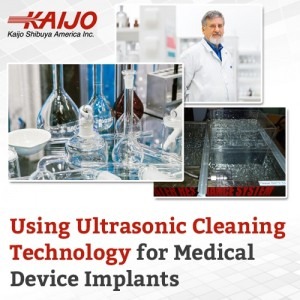Ultrasonic Cleaning for Medical Device Implant Applications
January 23, 2017
 Medical implants have rigorous FDA and other cleaning requirements while many implants may be delicate and high-value. If implants are not cleaned thoroughly they may introduce contaminants into the body, but if they are handled roughly during cleaning, they may suffer damage. Industrial ultrasonic cleaners can provide effective cleaning and rinsing with a cleaning action that is appropriate for even the most delicate devices. These systems rely on cavitation bubbles to clean a variety of parts and the intensity of the cleaning action can be adjusted by varying the ultrasonic frequency. Kaijo offers a complete range of ultrasonic cleaning systems ideal for medical cleaning applications and specifically for the cleaning of medical implants.
Medical implants have rigorous FDA and other cleaning requirements while many implants may be delicate and high-value. If implants are not cleaned thoroughly they may introduce contaminants into the body, but if they are handled roughly during cleaning, they may suffer damage. Industrial ultrasonic cleaners can provide effective cleaning and rinsing with a cleaning action that is appropriate for even the most delicate devices. These systems rely on cavitation bubbles to clean a variety of parts and the intensity of the cleaning action can be adjusted by varying the ultrasonic frequency. Kaijo offers a complete range of ultrasonic cleaning systems ideal for medical cleaning applications and specifically for the cleaning of medical implants.
Delicate Instruments
Medical devices may be structurally delicate or they may be made of materials that are compatible with body tissues but have easily damaged surfaces. It is critical that the structure of the device remains intact during cleaning and that smooth surfaces are not altered, damaged or pitted.
Traditional cleaning methods include mechanical means such as scrubbing and chemical methods with strong solvents. Both have disadvantages in that any scrubbing action may affect the structure of the device and solvents strong enough to remove stubborn contaminants may also attack smooth surfaces. Ultrasonic cleaning systems avoid these pitfalls by relying on ultrasonic waves for cleaning.
As an ultrasonic sound wave passes by the part to be cleaned, it creates microscopic bubbles in the cleaning solution. When the wave has passed, the bubbles collapse and deliver a powerful scrubbing action on the surface of the material to be cleaned. Lower ultrasonic frequencies create larger bubbles with a more intense cleaning action. By choosing a frequency appropriate for the level of cleaning intensity needed, ultrasonic cleaners can deliver the powerful cleaning required without damaging the medical device.
Hard-to-Clean Shapes
Medical device implants often have complicated shapes related to their function and the implant location. It is difficult to clean parts with odd angles and bumps or with dead end holes and crevices. With traditional cleaning methods the scrubbing tools pass over indentations or holes and apply extra pressure on bumps. Solvents may not penetrate dead end holes or concentrations may vary once some cleaning takes place.
With ultrasonic cleaners, the cleaning bubbles are evenly distributed throughout the cleaning solution, whether the solution is inside a hole or alongside a smooth surface. Cleaning action is rapid and thorough on all surfaces exposed to the cleaning solution. Foreign matter and contaminants are removed evenly everywhere.
Rinsing Medical Implants
Traditional cleaning methods leave powerful solvent residues on the implant and these are often difficult to remove completely. With ultrasonic cleaning systems, devices may be cleaned in water, but some contaminants require a mild solvent. Even when cleaning in water, rinsing is often necessary because the water has become contaminated with the foreign matter the ultrasonic cleaning has removed.
For rinsing as for cleaning, ultrasonic cleaners deliver improved performance and better outcomes compared to traditional methods. A bath in deionized water using ultrasonic cleaning removes all traces of chemicals and solvents through bubble action in the same places that were previously cleaned. The result is a clean medical device implant ready to be placed in a patient.
Kaijo’s Industrial Ultrasonic Cleaners
Kaijo’s ultrasonic cleaning systems are ideal for use in medical device transplant cleaning applications. The systems are available in a range of frequencies that can match any cleaning intensity required, from the most robust to extremely delicate. Kaijo can advise customers on the best system for their particular applications and can offer active support to clients who want to use ultrasonic cleaners for their medical implants.





